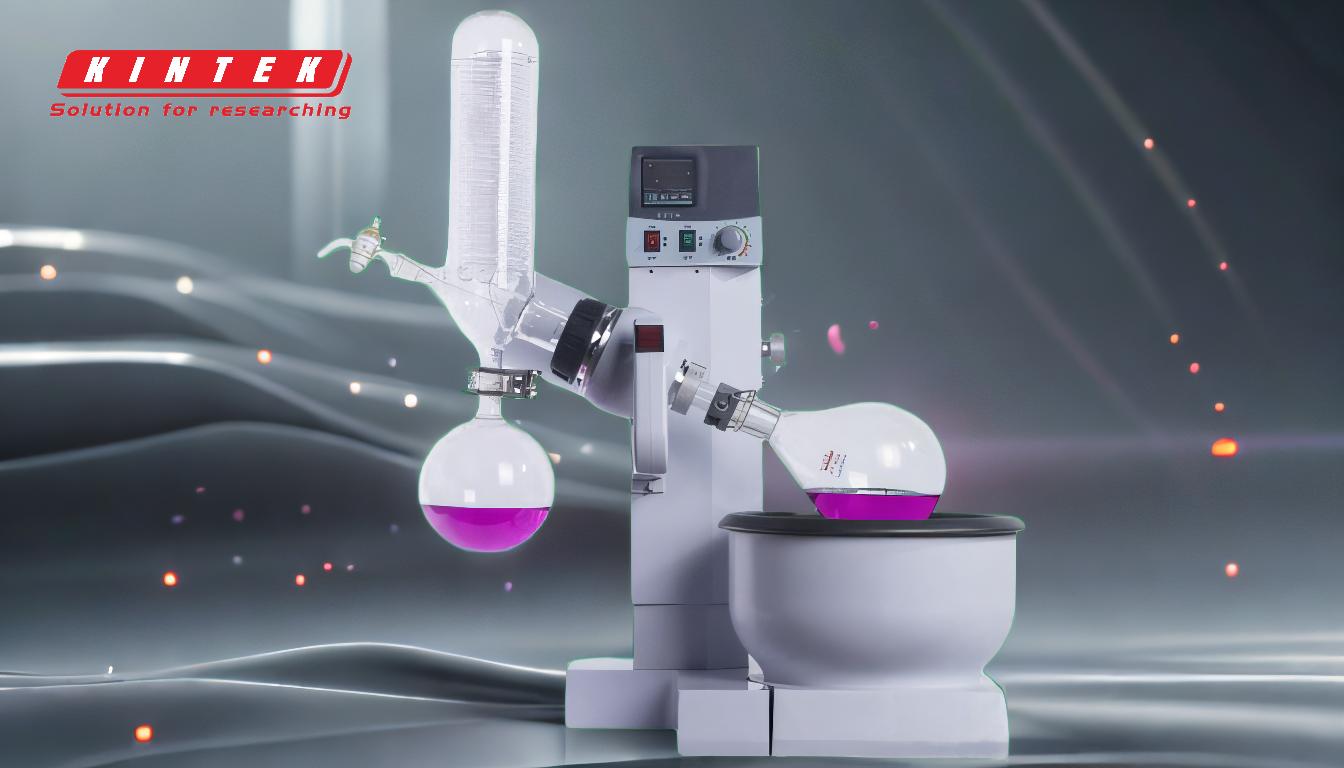A rotary evaporator, commonly referred to as a "rotovap," is a versatile laboratory instrument designed to efficiently remove volatile solvents from liquid mixtures through evaporation and condensation. It is widely used in fields such as medicinal chemistry, pharmaceuticals, chromatography, and biotechnology for processes like solvent recovery, concentration, crystallization, and separation. The rotary evaporator is particularly valuable for handling heat-sensitive materials, as it operates under reduced pressure, allowing for lower evaporation temperatures. This makes it ideal for isolating compounds, purifying biological products, and even applications in molecular cooking to retain volatile aromatics. Its ability to handle low-boiling solvents and its adaptability across industries underscore its importance in laboratory workflows.
Key Points Explained:

-
Core Function of a Rotary Evaporator:
- The primary purpose of a rotary evaporator is to remove volatile solvents from liquid mixtures. This is achieved through a combination of evaporation and condensation processes.
- By rotating the sample flask under reduced pressure, the solvent evaporates at a lower temperature, preventing degradation of heat-sensitive compounds.
-
Applications in Laboratories:
- Solvent Removal: Used to isolate desired compounds after processes like column chromatography or separatory-funnel extractions.
- Heat-Sensitive Procedures: Ideal for medical and biological research where maintaining the integrity of heat-sensitive materials is crucial.
- Molecular Cooking: Employed in gastronomy to retain volatile aromatics and flavors during non-heat evaporation processes.
-
Key Processes Enabled by Rotary Evaporators:
- Concentration: Reducing the volume of a solution by removing the solvent, leaving behind a more concentrated product.
- Crystallization: Facilitating the formation of crystals from a solution by evaporating the solvent.
- Drying: Removing solvents to obtain a dry product.
- Separation: Isolating specific components from a mixture.
- Solvent Recovery: Collecting and reusing solvents, which is both cost-effective and environmentally friendly.
-
Industries and Fields of Use:
- Pharmaceuticals: For purifying and concentrating active pharmaceutical ingredients (APIs) and other compounds.
- Chemical Engineering: Used in chemical reactions, mixing, and formulation processes.
- Biotechnology: Particularly suitable for concentrating and purifying biological products that are sensitive to high temperatures.
- Petrochemicals: Applied in distillation and separation processes.
-
Advantages of Using a Rotary Evaporator:
- Efficiency: Rapid removal of solvents under reduced pressure.
- Precision: Controlled evaporation temperatures prevent thermal degradation.
- Versatility: Suitable for a wide range of solvents and applications.
- Scalability: Can handle small-scale laboratory samples to larger industrial volumes.
-
Operational Mechanism:
- The rotary evaporator consists of a rotating flask, a heating bath, a condenser, and a vacuum system.
- The sample is placed in the rotating flask, which is partially immersed in a heated water or oil bath.
- As the flask rotates, the solvent evaporates and is condensed in the condenser, where it is collected in a separate flask.
-
Special Considerations:
- Low-Boiling Solvents: Rotary evaporators are particularly effective for solvents with low boiling points.
- Heat-Sensitive Materials: The reduced pressure operation minimizes the risk of thermal decomposition.
- Solvent Compatibility: Care must be taken to ensure the solvent is compatible with the materials used in the rotary evaporator.
-
Educational and Research Applications:
- Teaching: Used in academic settings to demonstrate principles of evaporation, condensation, and solvent recovery.
- Research: Essential for experimental procedures requiring precise control over solvent removal and compound isolation.
In summary, the rotary evaporator is a fundamental tool in modern laboratories, enabling efficient and precise solvent removal across a wide range of applications. Its ability to handle heat-sensitive materials and low-boiling solvents makes it indispensable in fields such as pharmaceuticals, biotechnology, and chemical engineering. Whether for research, industrial processes, or even culinary applications, the rotary evaporator plays a critical role in achieving desired outcomes with precision and efficiency.
Summary Table:
| Key Aspect | Details |
|---|---|
| Core Function | Removes volatile solvents through evaporation and condensation. |
| Applications | Solvent removal, heat-sensitive procedures, molecular cooking. |
| Key Processes | Concentration, crystallization, drying, separation, solvent recovery. |
| Industries | Pharmaceuticals, chemical engineering, biotechnology, petrochemicals. |
| Advantages | Efficiency, precision, versatility, scalability. |
| Operational Mechanism | Rotating flask, heating bath, condenser, vacuum system. |
| Special Considerations | Low-boiling solvents, heat-sensitive materials, solvent compatibility. |
| Educational Applications | Teaching evaporation principles, research for precise solvent removal. |
Ready to enhance your lab's efficiency with a rotary evaporator? Contact us today to learn more!













